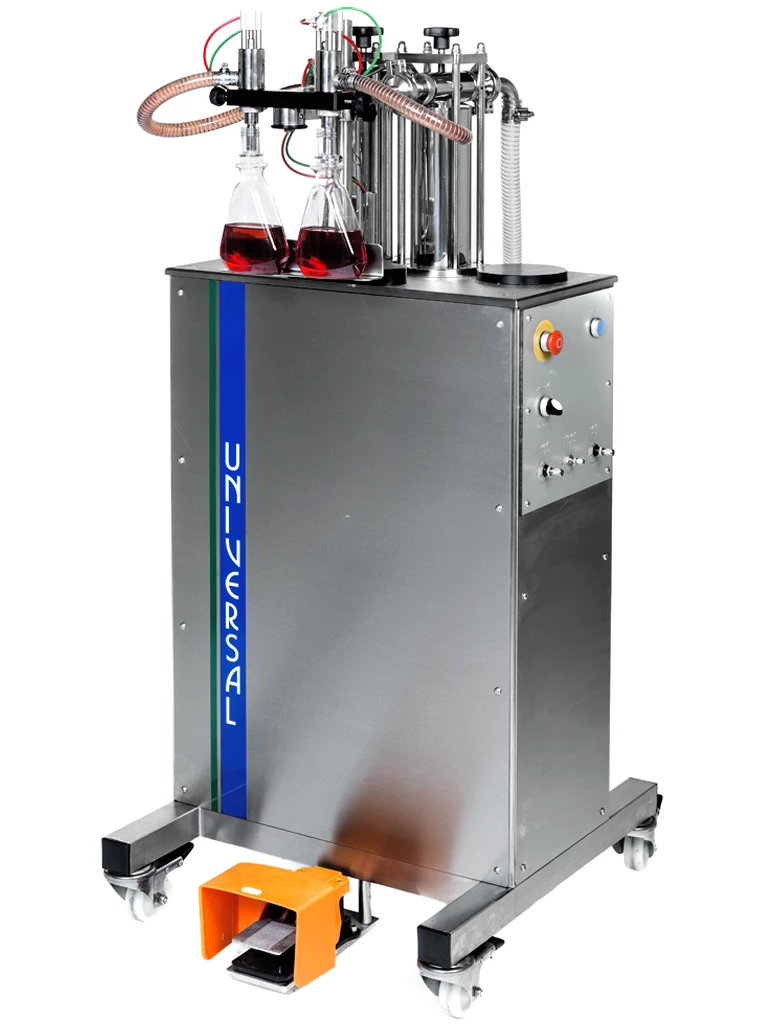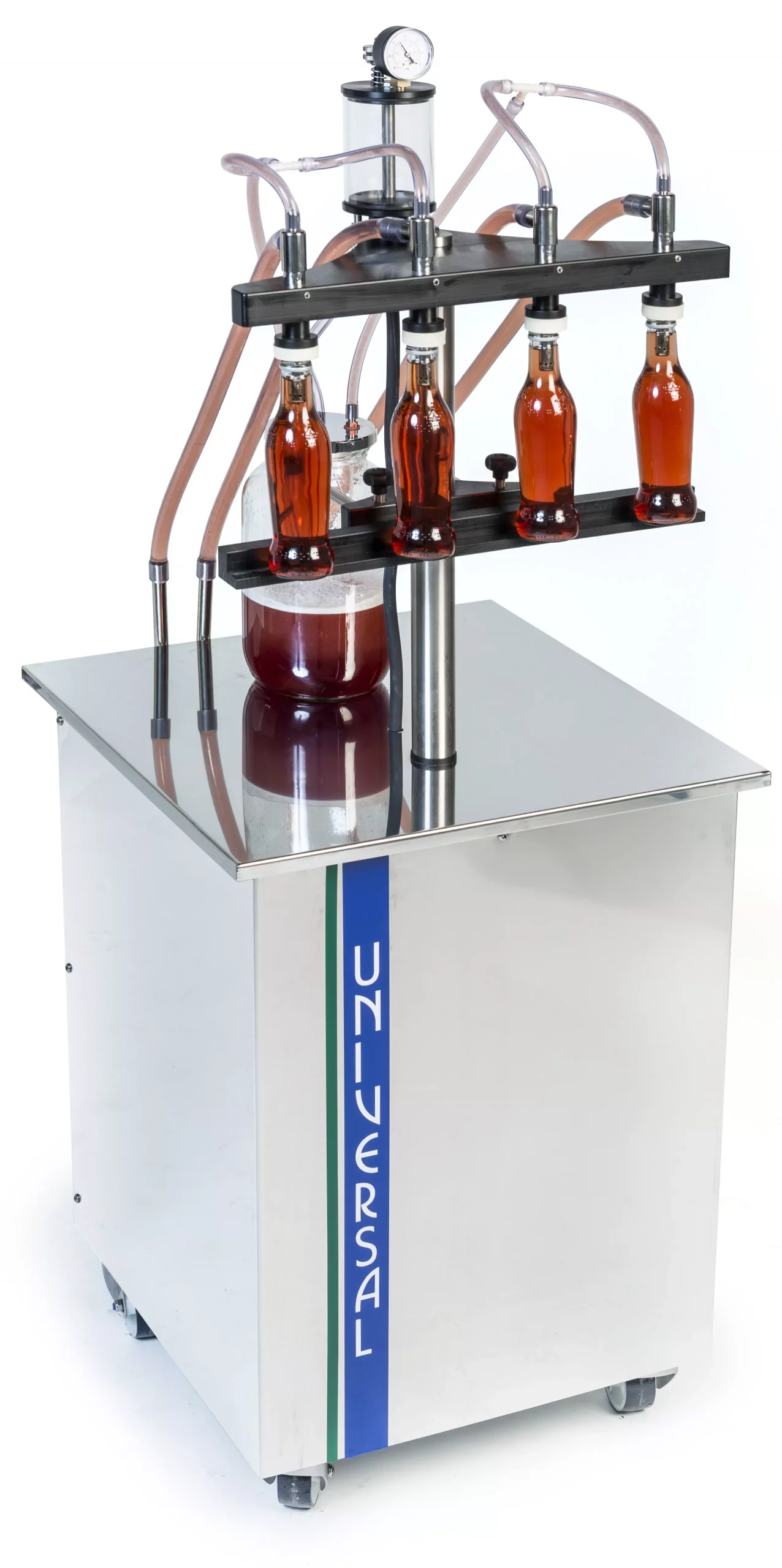Two distinct filling technologies are available for semi-automatic and fully automatic filling machines: volumetric and vacuum-level filling.
Manually operated filling machines tend only to fill volumetrically.
Volumetric filling machines
Manual liquid filling machines use a piston within a cylinder to force liquid into the container.
These normally have a pneumatically powered pump mechanism, set to fill containers with the required volume of liquid, fed from either a floor-standing container or a machine-mounted hopper.
Containers are positioned below the filling nozzles and a foot pedal switch to start the filling process.
Volumes between 5ml and 25-litres can be handled by volumetric filling machines and up to 150 containers per minute can be filled, depending on the fill volume, liquid viscosity and level of machine automation.

Vacuum level filling machines
Vacuum level semi-automatic filling machines use the rim at the top of the container to form an airtight seal around the filling nozzle.
This airtight seal creates a vacuum within the bottle which draws free-flowing liquids from a supply tank into the bottle, via specially designed nozzles. These nozzles have a small hole on the side which is connected to a small internal tube.
The height of this hole in relation to the top of the container during filling determines the level of liquid dispensed. The small hole in the nozzle scavenges excess liquid from the filling process and collects it in a receiver for reuse.
Vacuum level filling machines fill containers to the same height each time, rather than dispensing the same volume. This is particularly useful for glass bottles which will be side-by-side on display shelves in shops. Glass bottles vary in capacity quite a lot, yet vacuum-level filling ensures the level each bottle is filled to is the same, giving a consistent appearance from one bottle to the next. Vacuum level filling requires rigid containers which won’t collapse under a vacuum.

Vacuum-level machines have virtually no moving parts, making them incredibly reliable, and can fill up to 120 bottles per minute depending on the container type, number of filling heads and level of automation.
Bottles are simply positioned with their top in contact with a sealing ring around the nozzle. The container will start to fill as soon as an airtight seal is made and stop when the pre-determined fill height is reached.
Two distinct filling technologies are available for semi-automatic and fully automatic filling machines: volumetric and vacuum-level filling.
Manually operated filling machines tend only to fill volumetrically.
Volumetric filling machines
Manual liquid filling machines use a piston within a cylinder to force liquid into the container.
These normally have a pneumatically powered pump mechanism, set to fill containers with the required volume of liquid, fed from either a floor-standing container or a machine-mounted hopper.
Containers are positioned below the filling nozzles and a foot pedal switch to start the filling process.
Volumes between 5ml and 25-litres can be handled by volumetric filling machines and up to 150 containers per minute can be filled, depending on the fill volume, liquid viscosity and level of machine automation.

Vacuum level filling machines
Vacuum level semi-automatic filling machines use the rim at the top of the container to form an airtight seal around the filling nozzle.

This airtight seal creates a vacuum within the bottle which draws free-flowing liquids from a supply tank into the bottle, via specially designed nozzles. These nozzles have a small hole on the side which is connected to a small internal tube.
The height of this hole in relation to the top of the container during filling determines the level of liquid dispensed. The small hole in the nozzle scavenges excess liquid from the filling process and collects it in a receiver for reuse.
Vacuum level filling machines fill containers to the same height each time, rather than dispensing the same volume. This is particularly useful for glass bottles which will be side-by-side on display shelves in shops. Glass bottles vary in capacity quite a lot, yet vacuum-level filling ensures the level each bottle is filled to is the same, giving a consistent appearance from one bottle to the next. Vacuum level filling requires rigid containers which won’t collapse under a vacuum.
Vacuum-level machines have virtually no moving parts, making them incredibly reliable, and can fill up to 120 bottles per minute depending on the container type, number of filling heads and level of automation.
Bottles are simply positioned with their top in contact with a sealing ring around the nozzle. The container will start to fill as soon as an airtight seal is made and stop when the pre-determined fill height is reached.
Choosing the right liquid filling machine for your application can be a complex process, as there are several factors to consider.
Here are some key factors to keep in mind when selecting a liquid filling machine:
- Product type and viscosity: The type and viscosity of the liquid product you need to fill will determine the type of filling machine you need. For example, a piston filling machine is ideal for filling high-viscosity products, while a gravity filling machine is better suited for low-viscosity liquids.
- Container type and size: The type and size of the containers you need to fill will also impact your choice of filling machine. Some filling machines are designed for specific container types, such as bottles, jars, or pouches, while others can handle a range of container shapes and sizes.
- Production rate: The rate at which you need to fill containers will also influence your choice of filling machine. For high-volume production, you may need a machine that can fill thousands of containers per hour, while smaller batch production may require a slower, more manual process.
- Filling accuracy: Depending on your product and application, you may need a filling machine that can dispense precise volumes of liquid into each container. Some machines are more accurate than others, so consider your requirements for filling accuracy when selecting a machine.
- Maintenance and cleaning requirements: Filling machines require regular maintenance and cleaning to ensure optimal performance and hygiene. Consider the maintenance and cleaning requirements of the machine when making your selection, and choose a machine that is easy to maintain and clean.
Overall, choosing the right liquid filling machine will depend on a range of factors, and it’s important to carefully consider your product and application needs to make an informed decision. Consulting with a reputable filling machine supplier can also help you select the best machine for your needs.
